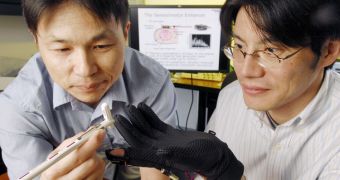Astronauts working on the International Space Station (ISS) could soon get another personal assistant device to help them during long extravehicular activities (EVA). The high-tech gloves are outfitted with sensors that will help spacewalkers improve their hand coordination, and also boost their sensitivity.
The vibrating globe is currently being developed by experts at the Georgia Institute of Technology (Georgia Tech), in Atlanta. They say that the boost in sensitivity wearers experience in their fingertips makes the glove useful for a wide number of fields, including neurosurgery.
Though science suspected for a long time that faint vibrations applied to fingertips makes them hyper-sensible, it was only recently that studies demonstrated the actual link between nimble fingers and an improved sense of touch.
According to Georgia Tech assistant professor of mechanical engineering Jun Ueda, the new system could benefit anyone from warfighters and jet fighter pilots to surgeons, oil rig workers and fishermen.
“It can be used in any case where you want to wear gloves but don't want to lose your sense of touch. And it's not limited to that application. What we're seeing are possible benefits for precise assembly tasks, such as when astronauts use a space tool during a spacewalk,” Ueda explains.
Interestingly, it may be possible to use the gloves for helping schoolchildren improve their handwriting, by providing them with feedback on how they are drawing each individual letter, Space reports.
“What I'm thinking is we may be able to help small kids with their handwriting skills, by helping them manipulate pencils or pens accurately so that they can make nice graphics or letters,” Ueda believes.
In order to understand how the new gloves work, it's important to consider how the human sense of touch works. All of us have receptors on our skin that relay impulses to the brain when they are activated. However, activation occurs in specific conditions.
The receptors only send electrical signals to the brain when the stimulus they experience is more intense than a certain threshold. What the glove does is partially account for that threshold. What this implies is that lower-intensity stimuli will be able to produce a signal.
Using this approach, it may be possible to create links between humans and robots, allowing us to maneuver robotic arms with tremendous accuracy and precision. In order for that to happen, gloves such as this need to be at the forefront of research.
“What we could do is artificially amplify the force by a factor of two or three and give the amplified force to the operator. Another strategy is that it might be OK to give the same amount of force, if the operator has better sensitivity by using our device,” Ueda concludes.

 14 DAY TRIAL //
14 DAY TRIAL //